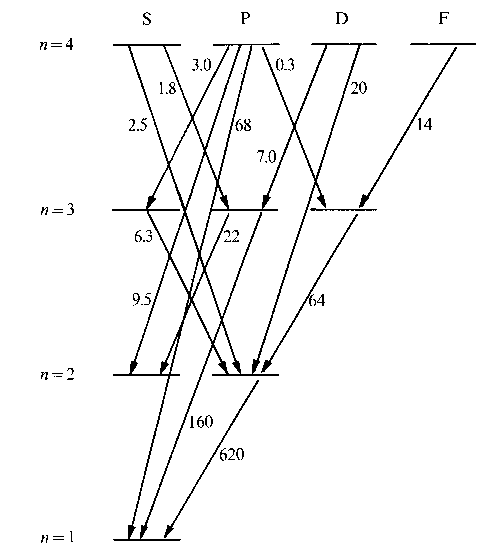 In the absence of a radiation field (uv = 0) the dynamical rate equations reduce
to:
In the absence of a radiation field (uv = 0) the dynamical rate equations reduce
to: dn2/dt = -An2.
With the boundary condition n2(0) = N, so initially all population in the excited state, this gives an exponential decay function, with A as the decay rate. Note that an excited level in a multi-level atom can decay in various ways following certain branching ratios, that are defined by the quantum mechanical transition rates. In the picture the decay rates for levels in hydrogen are displayed. The numbers are in 106 s-1.

So A is the inverse of the radiative lifetime of the excited state. In case of branching ratios the lifetime relates to the SUM of the decays.
 For all densities of the radiation field uv the inequality holds:
For all densities of the radiation field uv the inequality holds:Even without explicitly solving the dynamical rate equations it is intuitively understandable that for a boundary condition n1(0) = N, so all population initially in the ground state, the situation n2 > n1 can never be reached. Stated in other words: a population inversion cannot be achieved via optical pumping.
Or: an optically pumped two-level laser is not possible.


 From the perspective of quantum emchanics it is well understandable that the processes
of absorption and stimulated emission sale with the same constant.
It is the same transition dipole moment that governs both transitions. The eqaulity
B=C sets the excited and ground state on an equal footing.
The solutions of the time-independent Schrodinger equation are stationary states
and there is no straightforward explanation for the process of
"spontaneous emission". In principle stationary states do NOT decay.
The resolution of this contradiction lies in the theory that goes beyong
quantum mechanics: QED. There spontaneous emission is viewed upon as
stimulated by the photons created by the vacuum polarization.
From the perspective of quantum emchanics it is well understandable that the processes
of absorption and stimulated emission sale with the same constant.
It is the same transition dipole moment that governs both transitions. The eqaulity
B=C sets the excited and ground state on an equal footing.
The solutions of the time-independent Schrodinger equation are stationary states
and there is no straightforward explanation for the process of
"spontaneous emission". In principle stationary states do NOT decay.
The resolution of this contradiction lies in the theory that goes beyong
quantum mechanics: QED. There spontaneous emission is viewed upon as
stimulated by the photons created by the vacuum polarization.
 Last change: 18 February 2001
Last change: 18 February 2001